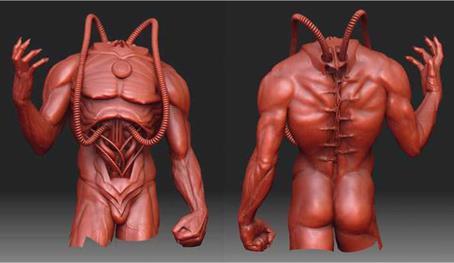![]() Using the computer
Using the computer
Elements of the design
The human body
Surface anatomy
Symmetry and proportion
Distinctions of gender, age, and ancestry
After the script, perhaps the next most important task is designing and creating the story’s physical characters. Of course, this will only apply to a story that needs physical alteration of the actors who will be playing characters. But this is where the fun begins, and having a solid understanding of human anatomy will make your job that much simpler and that much more enjoyable. Human physiology—the way the body works—is good knowledge to have also, though it’s not as critical as anatomy to the success or failure of a special makeup effects artist.
The way we move and the way we look is wholly dependent on our anatomy— our bone structure, how and where muscles attach, how big or small they are, what our skin looks and feels like, how and where hair grows; everything about us right down to the dirt under our fingernails should be studied and understood. Without this knowledge, our designs, sculptures, and ultimately our finished makeups would lack the sense of genuine depth and believability that a truly outstanding, memorable character must have if we are to succeed as makeup artists.
![]()
As artists, we will never be completely satisfied with our work. Accept that as a given. Nor should we be satisfied. That is the nature of the artist. No matter how good we get, there will always be something we could have done to make it better; we might not always know what that something is, it’s simply the way we are. I don’t think our work should ever be "good enough" for us. That’s not to say that we shouldn’t recognize when something is "finished" and move on to the next project, it’s just that there will always be room for improvement. In fact, I think that is a good gauge for us as artists: The moment we start thinking that there is nothing we can do improve, that is the moment for us to reevaluate what it is we’re doing and why.
Our work can always improve, and no matter how skilled we become, there will always be someone who can teach us something new. Iconic dancer/choreogra – pher Martha Graham once wrote to her dear friend and contemporary, legendary dancer/choreographer Agnes De Mille:
There is a vitality, a life force, a quickening, that is translated through you into action, and because there is only one of you in all time, this expression is unique. If you block it, it will never exist through any other medium and [will] be lost. The world will not have it. It is not your business to determine how good it is; nor how valuable it is; not how it compares with other expression. It is your business to keep it yours, clearly and directly, to keep the channel open. You do not even have to believe in yourself or your work. You have to keep open and aware directly to the urges that motivate you. Keep the channel open. No artist is ever pleased. There is no satisfaction whatever at any time. There is only a queer, divine dissatisfaction; a blessed unrest that keeps us marching and makes us more alive than the others.
|

